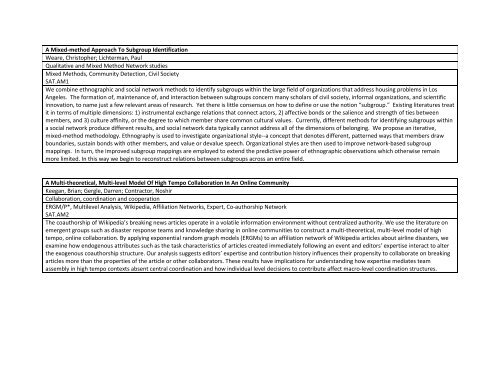Sunbelt XXXI International Network for Social Network ... - INSNA
Sunbelt XXXI International Network for Social Network ... - INSNA
Sunbelt XXXI International Network for Social Network ... - INSNA
You also want an ePaper? Increase the reach of your titles
YUMPU automatically turns print PDFs into web optimized ePapers that Google loves.
A Mixed‐method Approach To Subgroup IdentificationWeare, Christopher; Lichterman, PaulQualitative and Mixed Method <strong>Network</strong> studiesMixed Methods, Community Detection, Civil SocietySAT.AM1We combine ethnographic and social network methods to identify subgroups within the large field of organizations that address housing problems in LosAngeles. The <strong>for</strong>mation of, maintenance of, and interaction between subgroups concern many scholars of civil society, in<strong>for</strong>mal organizations, and scientificinnovation, to name just a few relevant areas of research. Yet there is little consensus on how to define or use the notion “subgroup.” Existing literatures treatit in terms of multiple dimensions: 1) instrumental exchange relations that connect actors, 2) affective bonds or the salience and strength of ties betweenmembers, and 3) culture affinity, or the degree to which member share common cultural values. Currently, different methods <strong>for</strong> identifying subgroups withina social network produce different results, and social network data typically cannot address all of the dimensions of belonging. We propose an iterative,mixed‐method methodology. Ethnography is used to investigate organizational style‐‐a concept that denotes different, patterned ways that members drawboundaries, sustain bonds with other members, and value or devalue speech. Organizational styles are then used to improve network‐based subgroupmappings. In turn, the improved subgroup mappings are employed to extend the predictive power of ethnographic observations which otherwise remainmore limited. In this way we begin to reconstruct relations between subgroups across an entire field.A Multi‐theoretical, Multi‐level Model Of High Tempo Collaboration In An Online CommunityKeegan, Brian; Gergle, Darren; Contractor, NoshirCollaboration, coordination and cooperationERGM/P*, Multilevel Analysis, Wikipedia, Affiliation <strong>Network</strong>s, Expert, Co‐authorship <strong>Network</strong>SAT.AM2The coauthorship of Wikipedia’s breaking news articles operate in a volatile in<strong>for</strong>mation environment without centralized authority. We use the literature onemergent groups such as disaster response teams and knowledge sharing in online communities to construct a multi‐theoretical, multi‐level model of hightempo, online collaboration. By applying exponential random graph models (ERGMs) to an affiliation network of Wikipedia articles about airline disasters, weexamine how endogenous attributes such as the task characteristics of articles created immediately following an event and editors’ expertise interact to alterthe exogenous coauthorship structure. Our analysis suggests editors’ expertise and contribution history influences their propensity to collaborate on breakingarticles more than the properties of the article or other collaborators. These results have implications <strong>for</strong> understanding how expertise mediates teamassembly in high tempo contexts absent central coordination and how individual level decisions to contribute affect macro‐level coordination structures.
















